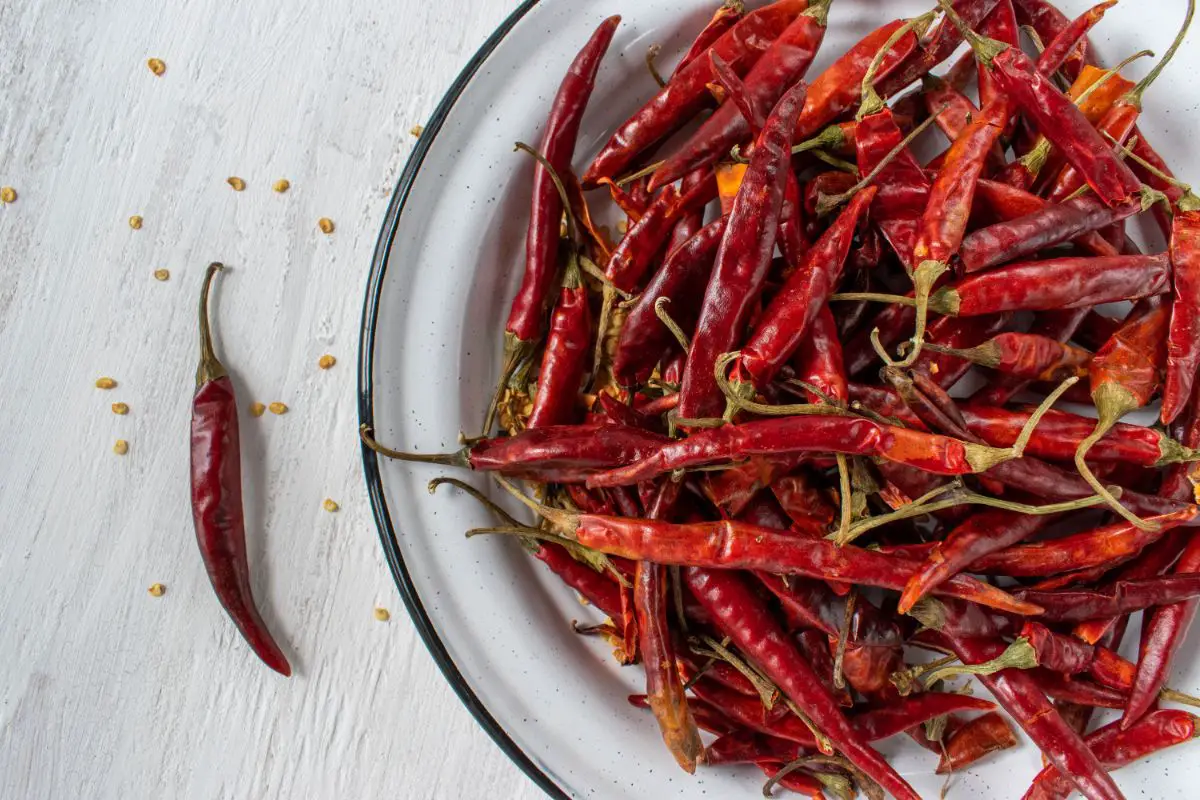Chile De árbol is a popular pepper variety found in Mexico, especially when it comes to its powdered form. It is a well-known ingredient in Mexican cuisine, however, it is making its way around the world, too.
That said, unless you live in Mexico, it can sometimes be difficult to come across this pepper. However, don’t worry, you can still make delicious meals without it.
With this in mind, this article will explore all the best substitutes for Chile De árbol. Thankfully, this chili variety is extremely similar to others easily accessible in the US.
Let’s get started.

What Is Chile De árbol?
Otherwise known as bird’s beak chile, chile de árbol is a small yet fiery pepper that is originally from Mexico.
Its name comes from its long, thin shape that resembles the beak of a bird.
Typically, chile de árbol is red, however, it can also be found in green and yellow varieties, too.
In terms of taste, it has a strong chili heat with a pungent flavor. Long after the pepper has been consumed, the heat will linger on your tongue.
As previously mentioned, chile de árbol is usually used in a range of Mexican dishes. For instance, it is often used in salsa verde and salsas.
Additionally, it can be used to add spice to stews and soups, too. If used in moderation, it can provide your meals with a bearable amount of heat.
That said, you should be careful when handling chile de árbol peppers since they can potentially cause skin irritation.
After touching them, you’ll want to wash your hands thoroughly and avoid touching your eyes or face.
1. Japones Chile
When it comes to the best alternative to Chile De árbol, japones chiles are certainly up there – sharing both appearance and taste.
Also referred to as Santika or Japanese peppers, this chile can often be found in Asian cuisine, especially when it comes to spicy Szechuan meals.
On the Scoville scale, it ranges from 15,000 to 30,000, therefore sharing the same amount of heat as chile de árbol.
You can use japones chiles as a replacement for chile de árbol, however, keep in mind that it has a more complex flavor and adds fire as opposed to depth to a meal.
They are ideal if you’re looking to make spicy vodka or hot pepper oils, although, will add intensity to sauces and salsa.
When replacing these ingredients, simply use equal amounts japones Chile for Chile De árbol.
2. Cayenne Pepper
Chile De árbol is commonly used in a dried or powdered form, therefore, the easiest alternative for this ingredient is cayenne pepper powder.
This spice can be used to provide your dishes with heat and is the ideal substitute for Chile De árbol.
Not only do cayenne peppers and chile de árbol share similar colors and shapes, but they also contain the same level of heat.
For instance, they share a Scoville rating of around 50,000 SHUs. Therefore, cayennes can add the same level of heat to your meals.
Moreover, it is beneficial to keep in mind that cayennes are extremely productive plants – meaning they can be easily grown in a container on your windowsill.
3. Chile Guajillo
This is another type of dried chili pepper that is commonly found in Mexican cuisine.
Chile Guajillo features mild to moderate heat with hints of fruity and smoky flavors. That said, the texture is somewhat tough, therefore, it is commonly found in a powder form.
Both chile de árbol and chile guajillo share similar flavors, however, the latter contains slightly more heat.
As such, you can use these peppers interchangeably to achieve your desired heat level.
When it comes to substituting these peppers, you’ll want to use around half as much chile de árbol for chile guajillo to prevent your dishes from being overwhelmingly spicy.
4. Red Pepper Flakes
When you can’t find dried or fresh chile de árbol, you’re sure to have some dried red pepper flakes hidden in your pantry.
Red pepper flakes, otherwise known as crushed red pepper, typically consist of cayenne peppers blended with a range of other, less intense, red peppers.
The result is a heat profile that is superior to chile de árbol, which is sure to pack a punch.
When you’re looking for heat as opposed to presentation or flavor, red pepper flakes are a great alternative to chile de árbol.
Here, you only need about a quarter or half a teaspoon of red pepper flakes when replacing a whole chile de árbol.
5. Thai Chillies
In the international section of your local supermarket, you’ll usually find Thai chilies. Therefore, if you’re looking for something to quickly replace chile de árbol, then these are great options.
That said, you should keep in mind that there is a big difference between these peppers when it comes to heat. In fact, Thai chilies are around three to four times hotter (50,000 to 30,000 SHU) than chile de árbol.
Despite their small size, they certainly pack a punch. Therefore, before using them, consider your recipe. Only using around a quarter of what is called in the recipe to add flavor.
Thanks to their slim shape, Thai chilies are also great for chili infusions.
6. Serrano Peppers
If you’re looking for a substitute for chile de árbol, then you can’t go wrong with Serrano peppers. Despite being sold in green, these peppers will ripen to bright red color, similar to chile de árbol.
These peppers are typically less spicy but feature a delicious flavor. Plus, they are relatively thin when compared to jalapenos. You can either dry these peppers yourself using an oven or a dehydrator or eat them fresh.
7. Pasilla Negro
This is another variety of chili peppers that can be commonly found in a range of Mexican cuisine.
As opposed to some other chili peppers, it features a slightly milder flavor with a sweeter taste.
These peppers are generally around 4-6 inches and, once they mature, they turn from a green color to a deep black color.
Pasilla negros peppers can typically be found in stews, sauces, and soups. Plus, they can also be dried and ground into chili powder, too.
When substituting this pepper for chile de árbol, you’ll want to keep the ratios the same. Otherwise, your dish may end up too spicy or not spicy enough.
Generally, you can substitute one Pasilla negro for one chile de árbol.
8. Piquín Pepper
Piquín Peppers make for a great alternative when it comes to chile de árbol. These small and elongated peppers are also known as rice peppers.
However, don’t let their size fool you. In fact, they are relentlessly hot, ranging between 40,000 to 60,000 SHU.
Originally from Mexico, piquín peppers can be eaten green, however, once ripened they turn a bright red color. Plus, they can be dried, too.
You can use these peppers as an excellent alternative to chile de árbol. Green piquíns are tangy and peppery – perfect for salsa.
On the other hand, once they ripen, they have a more complex flavor – featuring hints of citrus and smokiness. This is ideal for flavored oils, soups, and sauces.
Once dried, piquíns can add a rich and smoky flavor to chili con carne and BBQ sauces.
Since these small peppers are spicier than chile de árbol, you’ll want to only use about half the amount of piquín peppers to achieve the same taste and heat.
9. Cascabel Pepper
While the cascabel pepper contains nowhere near the same amount of heat as chile de árbol – what it lacks in spice, it certainly makes up for flavor!
It features an earth and nutty flavor that can add something special to your meals. If you’re looking for a flavor substitute, then this is an excellent choice.
Final Thoughts
Chile de árbol can add tons of flavor and spice to your meals. However, if you don’t have any in your pantry, then it isn’t the end of the world.
In fact, there are tons of alternatives you can choose from that contain similar flavors and textures to the chili.
Hopefully, this guide has informed you of all the best chile de árbol alternatives.
9 Best Chile De árbol Substitutes
Course: Substitutes4
servings30
minutes40
minutes300
kcalIf you can’t find Chile De árbol, don’t worry! There are a variety of substitutes you can use in your cooking. Check out the 9 best substitutes for Chile De árbol here.
Ingredients
Directions
- Decide on what substitute you need
- Pick a substitute from the list above
- Read what you need to substitute with
- Create the recipe and enjoy
Recipe Video
https://www.youtube.com/watch?v=O9_s28a-QgoVideo can’t be loaded because JavaScript is disabled: Growing Chile De Arbol – A Spicy Mexican Pepper Variety! (https://www.youtube.com/watch?v=O9_s28a-Qgo)- What Exactly Do Chickpeas Taste Like? Is There A Distinct Flavor? - September 30, 2023
- Top 11 Low Carb Options at Sonic Drive-In for Keto Diet - September 30, 2023
- What Should You Serve Alongside Potato Salad? 8 Incredible Side Dishes - September 30, 2023











